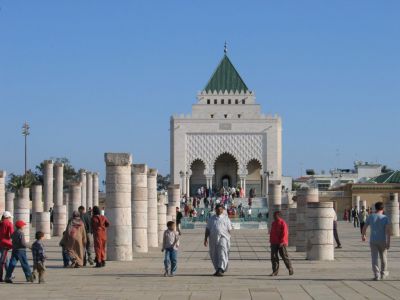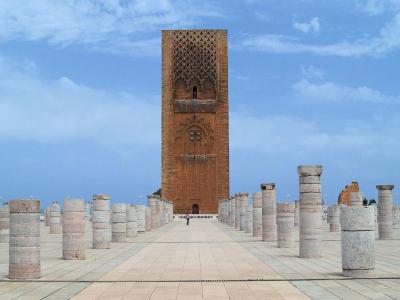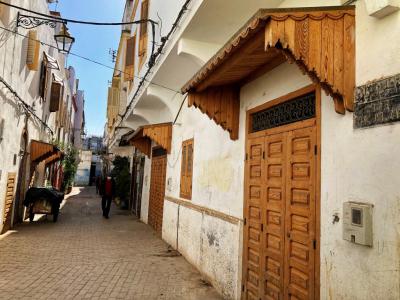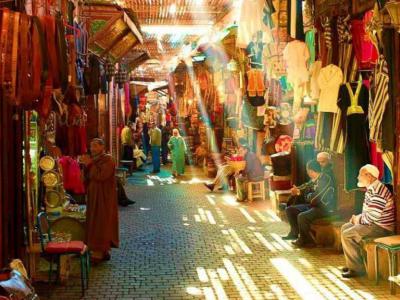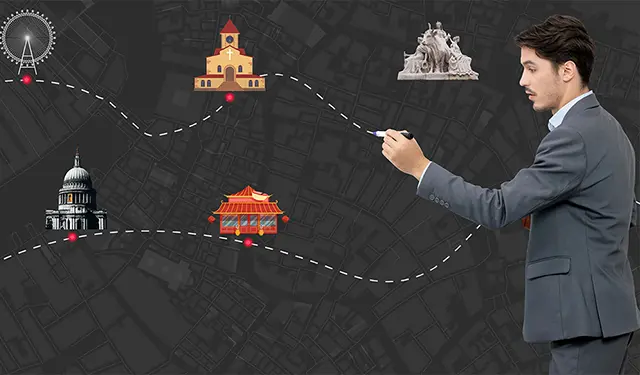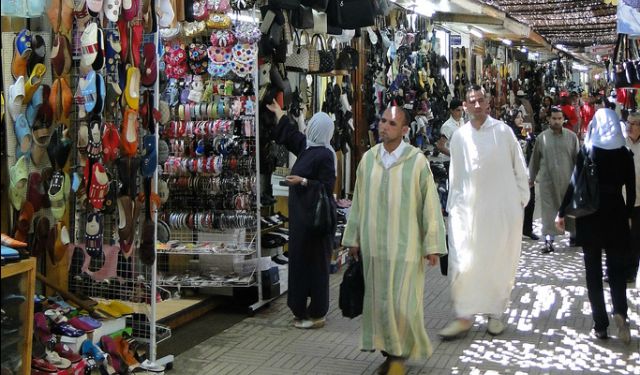
Rabat Introduction Walking Tour (Self Guided), Rabat
Resting on the shores of the Bouregreg River and Atlantic Ocean, the capital city of Morocco, Rabat, is known for its picturesque natural surroundings, much as for its man-made beauty manifested in a mix of old and new architecture (featuring Islamic and French-colonial styles), abundance of mosques and historic monuments. The Medina (Old City) of Rabat is a World Heritage Site.
Rabat was founded in 1170, as a naval base, by the Almohad Caliphate, a Berber Muslim empire which at the height of its might controlled much of the Iberian Peninsula and North Africa. The name Rabat comes from the Arabic word (er-Ribât) which means citadel. This name is short for (Ribâtu l-Feth) meaning the stronghold of victory, a title given by the Almohads when they established the city.
The Kasbah of the Oudaias, the oldest part of present-day Rabat, dates back to the city's early period. The Almohad caliph Abu Yusuf Ya'qub al-Mansur (reigned from 1184–1199) set out to construct a new fortified imperial capital, called Ribat al-Fath, on the site of what is now the Medina. This project also implied the construction of an enormous mosque, the remains of which include the Hassan Tower, an iconic minaret and one of the city's most prominent sights.
Following the collapse of the Almohad empire, the city went into an extended period of decline. In the 17th century Rabat became a haven for Barbary pirates (corsairs), who preyed on merchant ships around the shores of Western Europe. Corsair activities were based in the area below the Kasbah, on the south bank, which was more heavily populated, thanks to the Morisco and Andalusi refugees expelled from Spain by King Philip III in 1609. What is now known as Rue des Consuls (Street of the Consuls) became an important road artery back then.
The corsairs and then the 'Alawi dynasty refortified and expanded the citadel in the 17th and 18th centuries. Under Sultan Moulay Slimane (r. 1792–1822) a Jewish quarter, the Mellah, was created. In 1912, the French established a protectorate over Morocco and made Rabat its administrative center. After Morocco achieved independence in 1955, the city became the country's capital.
Rabat is also one of the four Imperial cities of Morocco. Adjacent to the Hassan Tower is the Mausoleum of King Mohammed V, completed in 1971 to a design by Vietnamese architect Cong Vo Toan.
For a more detailed acquaintance with the most famous attractions of the Moroccan capital, take this introductory walk.
Rabat was founded in 1170, as a naval base, by the Almohad Caliphate, a Berber Muslim empire which at the height of its might controlled much of the Iberian Peninsula and North Africa. The name Rabat comes from the Arabic word (er-Ribât) which means citadel. This name is short for (Ribâtu l-Feth) meaning the stronghold of victory, a title given by the Almohads when they established the city.
The Kasbah of the Oudaias, the oldest part of present-day Rabat, dates back to the city's early period. The Almohad caliph Abu Yusuf Ya'qub al-Mansur (reigned from 1184–1199) set out to construct a new fortified imperial capital, called Ribat al-Fath, on the site of what is now the Medina. This project also implied the construction of an enormous mosque, the remains of which include the Hassan Tower, an iconic minaret and one of the city's most prominent sights.
Following the collapse of the Almohad empire, the city went into an extended period of decline. In the 17th century Rabat became a haven for Barbary pirates (corsairs), who preyed on merchant ships around the shores of Western Europe. Corsair activities were based in the area below the Kasbah, on the south bank, which was more heavily populated, thanks to the Morisco and Andalusi refugees expelled from Spain by King Philip III in 1609. What is now known as Rue des Consuls (Street of the Consuls) became an important road artery back then.
The corsairs and then the 'Alawi dynasty refortified and expanded the citadel in the 17th and 18th centuries. Under Sultan Moulay Slimane (r. 1792–1822) a Jewish quarter, the Mellah, was created. In 1912, the French established a protectorate over Morocco and made Rabat its administrative center. After Morocco achieved independence in 1955, the city became the country's capital.
Rabat is also one of the four Imperial cities of Morocco. Adjacent to the Hassan Tower is the Mausoleum of King Mohammed V, completed in 1971 to a design by Vietnamese architect Cong Vo Toan.
For a more detailed acquaintance with the most famous attractions of the Moroccan capital, take this introductory walk.
How it works: Download the app "GPSmyCity: Walks in 1K+ Cities" from Apple App Store or Google Play Store to your mobile phone or tablet. The app turns your mobile device into a personal tour guide and its built-in GPS navigation functions guide you from one tour stop to next. The app works offline, so no data plan is needed when traveling abroad.
Rabat Introduction Walking Tour Map
Guide Name: Rabat Introduction Walking Tour
Guide Location: Morocco » Rabat (See other walking tours in Rabat)
Guide Type: Self-guided Walking Tour (Sightseeing)
# of Attractions: 5
Tour Duration: 1 Hour(s)
Travel Distance: 2.0 Km or 1.2 Miles
Author: alice
Sight(s) Featured in This Guide:
Guide Location: Morocco » Rabat (See other walking tours in Rabat)
Guide Type: Self-guided Walking Tour (Sightseeing)
# of Attractions: 5
Tour Duration: 1 Hour(s)
Travel Distance: 2.0 Km or 1.2 Miles
Author: alice
Sight(s) Featured in This Guide:
- Mausoleum of Mohammed V
- Hassan Tower
- Mellah of Rabat
- Rue des Consuls (Consuls Street)
- Kasbah des Oudaias (Oudaias Citadel)
1) Mausoleum of Mohammed V (must see)
The Mausoleum of Mohammed V is an architectural masterpiece located in Rabat, directly across from the unfinished Hassan Tower. Serving as the final resting place for King Mohammed V and his sons, King Hassan II and Prince Abdallah, this mausoleum is both a tribute to the late monarch and a symbol of Moroccan craftsmanship.
Commissioned by Hassan II following his father’s death in 1961, the mausoleum was designed by Vietnamese architect Cong Vo Toan. It embodies a harmonious blend of traditional Moroccan aesthetics and modern materials. The structure was completed in 1971, marking the official transfer of Mohammed V’s remains to the site. Prince Abdallah was interred here in 1983, and Hassan II in 1999.
The mausoleum stands on a raised platform at the southeastern corner of the esplanade of a former Almohad-era mosque, which also includes the Hassan Tower. Built of reinforced concrete, the exterior is clad in white marble, and adorned with Moorish-style porticos, polylobed arches, and intricate sebka motifs. A pyramidal green roof, the color symbolizing Islam, crowns the structure.
Inside, the mausoleum is richly decorated. The central chamber features a mahogany dome with colored glass, casting a warm, ambient glow over the tomb. The walls are covered in zellij tilework, and details are finished with chased brass, showcasing Moroccan artisanship. The white onyx cenotaph of Mohammed V, crafted by Ibn Abdelkrim, takes center stage, often accompanied by a Quran reciter seated nearby.
To the west of the mausoleum, an open-air pavilion was designed to house a museum dedicated to the Alaouite dynasty. A mosque was also built within the complex at a lower level, ensuring it does not obstruct views of the mausoleum or pavilion. Its hypostyle prayer hall, with separate sections for men and women, features a marble-paved courtyard (sahn).
Together, the mausoleum, Hassan Tower, and surrounding structures form one of Morocco’s most important historical and cultural landmarks, a place of reverence and an enduring testament to Moroccan identity.
Commissioned by Hassan II following his father’s death in 1961, the mausoleum was designed by Vietnamese architect Cong Vo Toan. It embodies a harmonious blend of traditional Moroccan aesthetics and modern materials. The structure was completed in 1971, marking the official transfer of Mohammed V’s remains to the site. Prince Abdallah was interred here in 1983, and Hassan II in 1999.
The mausoleum stands on a raised platform at the southeastern corner of the esplanade of a former Almohad-era mosque, which also includes the Hassan Tower. Built of reinforced concrete, the exterior is clad in white marble, and adorned with Moorish-style porticos, polylobed arches, and intricate sebka motifs. A pyramidal green roof, the color symbolizing Islam, crowns the structure.
Inside, the mausoleum is richly decorated. The central chamber features a mahogany dome with colored glass, casting a warm, ambient glow over the tomb. The walls are covered in zellij tilework, and details are finished with chased brass, showcasing Moroccan artisanship. The white onyx cenotaph of Mohammed V, crafted by Ibn Abdelkrim, takes center stage, often accompanied by a Quran reciter seated nearby.
To the west of the mausoleum, an open-air pavilion was designed to house a museum dedicated to the Alaouite dynasty. A mosque was also built within the complex at a lower level, ensuring it does not obstruct views of the mausoleum or pavilion. Its hypostyle prayer hall, with separate sections for men and women, features a marble-paved courtyard (sahn).
Together, the mausoleum, Hassan Tower, and surrounding structures form one of Morocco’s most important historical and cultural landmarks, a place of reverence and an enduring testament to Moroccan identity.
2) Hassan Tower (must see)
The Hassan Tower (Tour Hassan) is the unfinished minaret of an ambitious mosque project commissioned by Abu Yusuf Yaqub al-Mansur, the third caliph of the Almohad Caliphate, in the late 12th century. Intended to be the tallest minaret in the world and part of what would have been the largest mosque in the western Islamic world, the project was abruptly halted in 1199 upon the caliph’s death. What remains today is a 44-meter-tall minaret, the unfinished mosque’s 348 columns, and portions of its walls, forming a historical and architectural complex alongside the modern Mausoleum of Mohammed V.
Al-Mansur of the Almohad dynasty envisioned Rabat as a grand capital, naming it Ribat al-Fath. His plan included fortifications, monumental gates, and an immense mosque, with Hassan Tower as its highlight. Inspired by the Koutoubia Mosque, Seville's Giralda, and the Lighthouse of Alexandria, it featured ramps instead of stairs for a horseback ascent. Had it been completed, the mosque would have surpassed the Great Mosque of Córdoba in size, with stone columns replacing the usual Almohad brick piers—a challenge that may have led to its abandonment. Its design also included three inner courtyards for added light and airflow.
Though incomplete, the mosque suffered additional damage during the 1755 Lisbon earthquake, leading to the further collapse of its structure. In the 20th century, both French colonial and Moroccan archaeologists worked to preserve and reconstruct the site. In the 1960s, the area was transformed to accommodate the Mausoleum of Mohammed V, completed in 1971 under the design of Vietnamese architect Cong Vo Toan. The Hassan Tower site was later inscribed as part of Rabat’s UNESCO World Heritage designation in 2012.
Today, the Hassan Tower stands as a red ochre sandstone relic of a grand Almohad vision, visible from afar due to its strategic placement overlooking the Bu Regreg River. Despite its unfinished state, its ornate sebka patterns, engaged columns, and horseshoe-shaped windows remain a testament to the architectural ambition of the Almohads. Along with the nearby mausoleum, it serves as one of Rabat’s most significant historical and touristic landmarks.
Al-Mansur of the Almohad dynasty envisioned Rabat as a grand capital, naming it Ribat al-Fath. His plan included fortifications, monumental gates, and an immense mosque, with Hassan Tower as its highlight. Inspired by the Koutoubia Mosque, Seville's Giralda, and the Lighthouse of Alexandria, it featured ramps instead of stairs for a horseback ascent. Had it been completed, the mosque would have surpassed the Great Mosque of Córdoba in size, with stone columns replacing the usual Almohad brick piers—a challenge that may have led to its abandonment. Its design also included three inner courtyards for added light and airflow.
Though incomplete, the mosque suffered additional damage during the 1755 Lisbon earthquake, leading to the further collapse of its structure. In the 20th century, both French colonial and Moroccan archaeologists worked to preserve and reconstruct the site. In the 1960s, the area was transformed to accommodate the Mausoleum of Mohammed V, completed in 1971 under the design of Vietnamese architect Cong Vo Toan. The Hassan Tower site was later inscribed as part of Rabat’s UNESCO World Heritage designation in 2012.
Today, the Hassan Tower stands as a red ochre sandstone relic of a grand Almohad vision, visible from afar due to its strategic placement overlooking the Bu Regreg River. Despite its unfinished state, its ornate sebka patterns, engaged columns, and horseshoe-shaped windows remain a testament to the architectural ambition of the Almohads. Along with the nearby mausoleum, it serves as one of Rabat’s most significant historical and touristic landmarks.
3) Mellah of Rabat
The Mellah of Rabat stands as a testament to the unique Jewish history of Morocco. Unlike other historical quarters in the city, the Mellah of Rabat is relatively new, having been established in 1808 during the reign of Sultan Moulay Slimane ben Mohammed. Initially conceived as a designated enclave for the Jewish community, it was enclosed by walls with multiple entry points, reflecting the broader historical trend of Jewish segregation within Moroccan cities.
Perched on the cliffs overlooking the Bouregreg River, the Mellah of Rabat developed a character distinct from other neighborhoods in the city. Its streets, alive with merchants and vendors, became a hub of commerce and daily interaction. Jewish residents built entire neighborhoods within the Mellah, naming streets after prominent families such as Rue du Rabbi Shalom Zaoui and Rue David-Cohen, underscoring their deep-rooted presence in the area.
Historically, mellahs in Morocco functioned as designated Jewish quarters, often located near the royal palace, a citadel, or the residence of the governor. This placement was strategic, ensuring proximity to Jewish administrators who held key positions within the governing framework. While originally intended as spaces of segregation, mellahs also fostered close-knit Jewish communities that developed their markets, synagogues, cemeteries, and social institutions.
Trade was vital in Rabat’s Mellah, with Jewish merchants and artisans driving commerce. Positioned near trade routes, its market attracted both Jewish and Muslim buyers, fostering cultural exchange despite physical separation. Though conditions declined over time, the Mellah remained a key center of Jewish communal life, with synagogues, kosher markets, and schools.
The Mellah of Rabat, though relatively younger than other Jewish quarters in Morocco, remains an important historical and cultural site. It tells the story of a community that, despite imposed separations, thrived through commerce, religious life, and cultural resilience. Today, remnants of the Mellah, such as the Rabbi Shalom Zaoui Synagogue and the lively streets that once bustled with trade, continue to echo the legacy of Rabat’s Jewish past.
Perched on the cliffs overlooking the Bouregreg River, the Mellah of Rabat developed a character distinct from other neighborhoods in the city. Its streets, alive with merchants and vendors, became a hub of commerce and daily interaction. Jewish residents built entire neighborhoods within the Mellah, naming streets after prominent families such as Rue du Rabbi Shalom Zaoui and Rue David-Cohen, underscoring their deep-rooted presence in the area.
Historically, mellahs in Morocco functioned as designated Jewish quarters, often located near the royal palace, a citadel, or the residence of the governor. This placement was strategic, ensuring proximity to Jewish administrators who held key positions within the governing framework. While originally intended as spaces of segregation, mellahs also fostered close-knit Jewish communities that developed their markets, synagogues, cemeteries, and social institutions.
Trade was vital in Rabat’s Mellah, with Jewish merchants and artisans driving commerce. Positioned near trade routes, its market attracted both Jewish and Muslim buyers, fostering cultural exchange despite physical separation. Though conditions declined over time, the Mellah remained a key center of Jewish communal life, with synagogues, kosher markets, and schools.
The Mellah of Rabat, though relatively younger than other Jewish quarters in Morocco, remains an important historical and cultural site. It tells the story of a community that, despite imposed separations, thrived through commerce, religious life, and cultural resilience. Today, remnants of the Mellah, such as the Rabbi Shalom Zaoui Synagogue and the lively streets that once bustled with trade, continue to echo the legacy of Rabat’s Jewish past.
4) Rue des Consuls (Consuls Street)
Rue des Consuls (Street of the Consuls) is one of the oldest and most famous streets in Rabat, classified as a historic monument. Indeed, the history of this area goes back 500 years. In 1609, King Philip III of Spain expelled all the Moriscos (people of Muslim or Moorish descent) from the country, a good number of whom (up to 14,000) settled in Rabat and neighboring Salé, in 1627. The autonomous Corsair Republic of Salé that they formed became a base for corsairs (pirates), who preyed on merchant ships around the shores of Western Europe. Back then, the area below the Kasbah, on the south bank, grew heavily populated, and the territory of today's Rue des Consuls became an important road artery.
It was during that time that the first ambassadors came here to negotiate the release of prisoners kept by the pirates. The most famous of them, perhaps, was Louis Chénier, father of the French poet André Chénier, who served here for from 1768 to 1782, representing King of France.
Pursuant to a treaty signed with the Sultan, foreign diplomats were allowed to buy back their compatriots from the pirate captivity at the Souk El Ghazal in the special "negotiation zone". Owing to this, for centuries, first during the Republic of Salé and then under the Chérifien Empire, up until 1912, this neighborhood had been a home to numerous ambassadors and consuls, particularly European ones. Today, it still houses residences of the Swedish, Danish and Dutch envoys.
Also, Rue des Consuls is a home to the landmark craft souk renowned for the traditional carpets, rugs, jewelry, leather, silks, lamps, wooden furniture and of course the traditional babouches (loose garments) and jellabahs (slippers) sold here in abundance and attracting many tourists. Here, alongside handmade tagine pottery and other authentic stuff, you can also find dried fruits and various types of Moroccan spices.
It was during that time that the first ambassadors came here to negotiate the release of prisoners kept by the pirates. The most famous of them, perhaps, was Louis Chénier, father of the French poet André Chénier, who served here for from 1768 to 1782, representing King of France.
Pursuant to a treaty signed with the Sultan, foreign diplomats were allowed to buy back their compatriots from the pirate captivity at the Souk El Ghazal in the special "negotiation zone". Owing to this, for centuries, first during the Republic of Salé and then under the Chérifien Empire, up until 1912, this neighborhood had been a home to numerous ambassadors and consuls, particularly European ones. Today, it still houses residences of the Swedish, Danish and Dutch envoys.
Also, Rue des Consuls is a home to the landmark craft souk renowned for the traditional carpets, rugs, jewelry, leather, silks, lamps, wooden furniture and of course the traditional babouches (loose garments) and jellabahs (slippers) sold here in abundance and attracting many tourists. Here, alongside handmade tagine pottery and other authentic stuff, you can also find dried fruits and various types of Moroccan spices.
5) Kasbah des Oudaias (Oudaias Citadel) (must see)
Perched atop a hill at the mouth of the Bou Regreg River, adjacent to Rabat’s old Medina, stands the Oudaias Citadel (Kasbah des Oudaias), a UNESCO World Heritage Site.
The northern section of this citadel dates back to the 12th century, constructed during the Almohad period under Caliph Ya'qub al-Mansur. At its heart lies Rue Jamaa (Mosque Street), which stretches from Bab Oudaia ("Udaya Gate") to the semaphore platform, passing by the Kasbah’s Old Mosque.
The monumental Bab Oudaia, also known as Bab al-Kbir ("Great Gate"), is widely regarded as one of Morocco’s finest architectural masterpieces. Built between 1195 and 1199, it was originally part of the Kasbah’s early fortifications, erected around 1150. Later, as new walls enclosed the area, the gate, despite its massive structure, took on a more ceremonial role rather than a defensive one.
Both its outer and inner façades are adorned with intricate carvings. The horseshoe arch entrance is framed by an elaborate band of interwoven geometric patterns—specifically, the darj wa ktaf motif, a hallmark of Moroccan architecture—set within a rectangular border that bears a Qur’anic inscription in Kufic Arabic script.
The inner gate’s external façade, facing the Kasbah, features similar ornamentation, albeit with slight variations in geometric design. Inside, the gatehouses have three chambers arranged in a bent passage.
The southern section of the Kasbah dates from the 18th century, built during the Alaouite period. This area is largely occupied by the Andalusian Gardens, the Oudayas Museum, and a scenic terrace known as Café Maure.
The northern section of this citadel dates back to the 12th century, constructed during the Almohad period under Caliph Ya'qub al-Mansur. At its heart lies Rue Jamaa (Mosque Street), which stretches from Bab Oudaia ("Udaya Gate") to the semaphore platform, passing by the Kasbah’s Old Mosque.
The monumental Bab Oudaia, also known as Bab al-Kbir ("Great Gate"), is widely regarded as one of Morocco’s finest architectural masterpieces. Built between 1195 and 1199, it was originally part of the Kasbah’s early fortifications, erected around 1150. Later, as new walls enclosed the area, the gate, despite its massive structure, took on a more ceremonial role rather than a defensive one.
Both its outer and inner façades are adorned with intricate carvings. The horseshoe arch entrance is framed by an elaborate band of interwoven geometric patterns—specifically, the darj wa ktaf motif, a hallmark of Moroccan architecture—set within a rectangular border that bears a Qur’anic inscription in Kufic Arabic script.
The inner gate’s external façade, facing the Kasbah, features similar ornamentation, albeit with slight variations in geometric design. Inside, the gatehouses have three chambers arranged in a bent passage.
The southern section of the Kasbah dates from the 18th century, built during the Alaouite period. This area is largely occupied by the Andalusian Gardens, the Oudayas Museum, and a scenic terrace known as Café Maure.
Walking Tours in Rabat, Morocco
Create Your Own Walk in Rabat
Creating your own self-guided walk in Rabat is easy and fun. Choose the city attractions that you want to see and a walk route map will be created just for you. You can even set your hotel as the start point of the walk.
Rabat Shopping Walk
Rabat is heaven for those who love shopping. Indeed, the abundance of shopping opportunities – traditional markets and shopping streets – in this city gives no reason to doubt that. There you can find all kinds of oriental delights you can possibly think of.
One of Rabat's top shopping destinations is Consuls Street (rue des Consuls). Steeped in a 500-year history, this street houses... view more
Tour Duration: 1 Hour(s)
Travel Distance: 1.0 Km or 0.6 Miles
One of Rabat's top shopping destinations is Consuls Street (rue des Consuls). Steeped in a 500-year history, this street houses... view more
Tour Duration: 1 Hour(s)
Travel Distance: 1.0 Km or 0.6 Miles
The Most Popular Cities
/ view all
